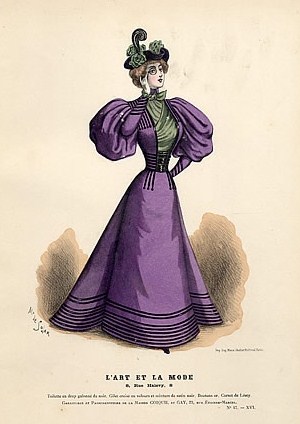
Using original existing garments as inspiration for replication is wonderful. But there’s just something about a historical fashion plate that pushes you to bring it to life.
True, a drawing from a century or two ago was the epitome of fashion that was presented to ladies of the time. But as our glossy Vogues and In-Styles present runway fashion today that you rarely see on your friends, plate sketches from the past gave the contemporary woman (and us) the dream to chase after.
Of course, loads of details go into the production of the chosen plate design, many of which we stumble through. We analyze, scrutinize, ponder, decide, and create. Somehow at the end of it, we’re left with a beautiful garment – even if it doesn’t resemble the original design at all.
Before starting your reproduction, study these considerations to keep you on track.
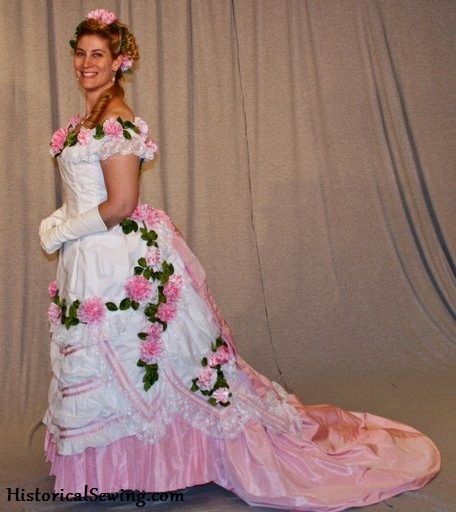
1st: Accept that you don’t look like the fashion plate
In 2008 when I absorbed myself in reproducing the Godey’s July 1876 plate, I discovered, much to my dismay and education, that I am about 6″ shorter between my waist and knees than the drawing. Shucks.
I accepted that fact easily. But then I had to work out a plan to scale down the design so that my dress still mimicked the plate. Not exactly easy when dealing with a detailed, multi-layered bustle overskirt! But it worked, as you can tell.
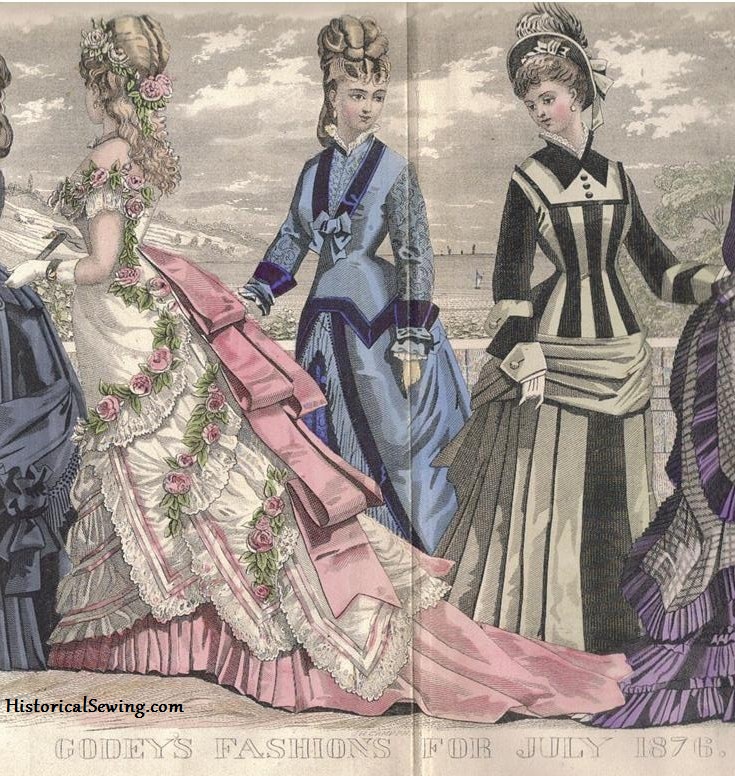
So, make sure to allow for adjustments when constructing the design. Work with as many mockups as you need to allow for the tweaking that always comes with reproductions. And remember you won’t ever look like the ideal of the time.
Also, before you begin, measure yourself and the fashion plate and figure proportions between them.
If the plate is 5″ high on paper and you stand at 5’4″, you can then break this down into sections, like neck to waist, waist to knees and knees to hem, to proportionally calculate how long pieces of the garment will be when on a real person. I use this method a great deal when reproducing a fashion plate.
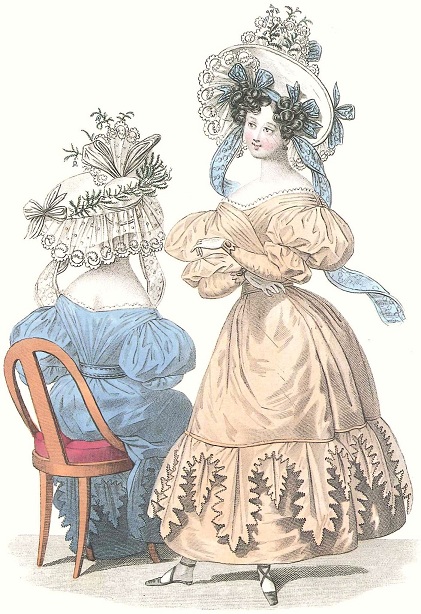
2nd: Take time to look at the details & each section of the garment
Before you can reproduce a fashion plate, you have to know what it looks like. Now before you say “duh!” let me tell you: just because you can see a full skirt and puffed sleeves, you’ll find loads more details than on first glance.
Now grab your plate, some paper, and pencils and let’s start the dissection.
Initially, stick with only what is visible in the plate. A full skirt. Puffed sleeves at the top, then a smaller puff, and finally a long, tight lower sleeve. A pleated bertha collar around the neckline. Some fancy cut trim on the skirt topped with a roll or band. Looks like the entire dress is from one fabric. Etc. Etc.
Write down all you see. Fill in your picture on paper. Look closer. Re-sketch the plate to give you an idea of all involved. (This is a great way to develop design skills – like figuring out how you get dressed in the garment.)
Next, start thinking about pattern shapes. What would the pieces look like?
The skirt is probably cut from straight panels. The bodice, fitted with darts. The sleeves could be leg o’ mutton with a band around it.
Start researching patterns that come close to the various sections of your plate design. You may have to combine a couple to produce the final result. And don’t feel bad for doing so! You are trying to bring a particular design to life, not make up a commercial pattern as is. But they do help immensely as a jumping off point.
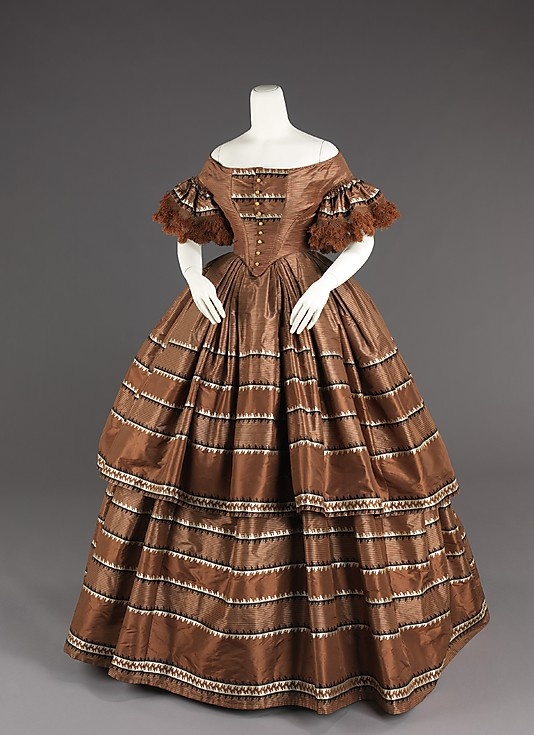
3rd: Know the time period you are working on – do research
If you want to make a dress from the mid-Victorian era, and have found a to-die-for fashion plate, you’re going to have to know a little bit about how dresses were constructed back then. Simply getting a pattern and fabric and sewing it up won’t cut it.
Successful reproductions start with an accurate silhouette. Researching what goes under that dress, like a chemise, hoopskirt and petticoats, gives you a solid foundation to start with.
That fashion plate would look awful without the undergarments. Remember, it was produced from the time, so everyone knew what was worn under it. We, however, have to find out.
Museum websites and books like Nineteenth Century Fashion in Detail, Costume in Detail, and Patterns of Fashion are packed with period details, measurements and photos of the real thing, helping us create our own versions of antique garments.
Have you tried Pinterest lately? Oh my! You can get lost in your research, but that may be a good thing. The more you know of a particular era, the higher quality you’ll construct your garment.
General questions to make note of: Are the skirts lined? Where do the bodices open (front or back)? Which seams are hand-sewn? Are trims sewn into seams or mounted on top? What are the most popular fabrics?
Remember here, you want to get a good overall picture of the time period. If something seems odd or pops up only once, it’s probably not a mainstream idea – and a fashion plate IS the mainstream. Stay with the general construction techniques, those most popular in what you find.
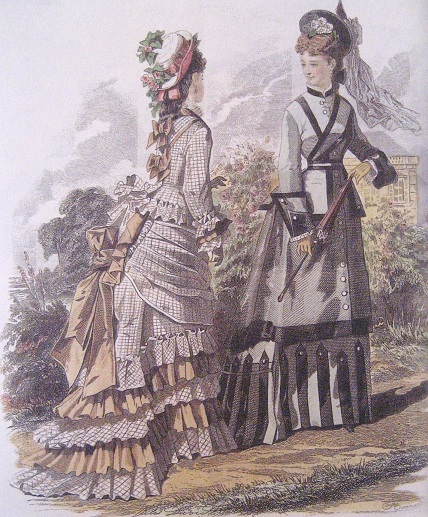
4th: Decision-Making Time
N0w that you know a bit more of your fashion plate era, have studied the details, and looked for patterns, it’s time to finalize your design.
This is where it comes down to “What do YOU want the design to look like?” The best reproductions reflect your personality and skill. Finalize your garment to what you want. This means making some decisions.
Because a fashion plate only gives us one side of the garment, it comes naturally that we have to do some guesswork. What DOES the front of that bustle dress look like? Is there a bow on the back of that belt?
This part can stump even seasoned costumers. But be brave. Based on your new knowledge of the period, select a design that runs in tandem with it. Add a collar. Scoop the neckline. Add a big honkin’ flower to the center front décolleté. Decide on hooks & hand eyelets to close the back. Carry the hem ruffle around to the front.
Don’t be timid, and don’t fizzle out. Push through and simply make a choice. Or rather oodles of them. Force yourself to step out of your zone and attempt something fabulous!
Fashion plates open up a dream world. One that is “perfect” to our historical costuming eyes. Use them in delicious fashion to build up your period wardrobe. Have fun!
Have you made reproductions from fashion plates? Do you find using plates useful in your historical sewing?
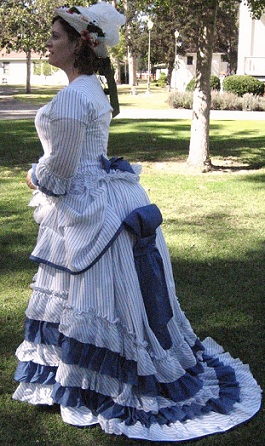

Jennifer, when you bring a fashion illustration/plate into real life, do we have to make the pattern of the garment first, and copy the dress
I recommend either drafting a pattern to match what you see in the fashion plate or finding a published pattern that is similar to start with and tweak to the plate design from there.
My friend and I challenged each other to make a dress from a single fashion plate with 2 dresses on it. We chose the plate and have made the dresses. It was the first time I draped and drafted an 1880’s pattern. Worked out a dream and was a fun challenge. I am now more adventurous in my dressmaking as I have learnt not to follow the pattern but make my own way to the end.
Thank you for this excellent article! I have always wanted to try this (all of my historical dresses have been made from patterns and only altered to fit my height and corsetted shape). There are so many details, particularly the one about figuring out the dimensions of neck to waist, waist to knees etc.) There is so much good material in this article that I feel I have a real jumping off point for making a dress from a fashion plate that I have been drooling over for years!
Yay! Best of luck as you start making your dream costumes! 😀
I have found your website to be most helpful, both in improving my sewing skills and problem solving with my historical sewing. Thank you so much! I was also wondering where you find your fashion plates? Is there a book or website that you would recommend? Thank you!! 🙂
So glad Christin. Welcome! As for fashion plates, I own dozens of original periodicals/magazines with the original plates so any that are watermarked HistoricalSewing.com are from my collection. After that, I find them online on Pinterest, in other books (Timely Tresses have many books of plates), and on eBay to purchase. 🙂
Christin C., there is a website called Hathitrust.org that is packed with fashion magazines! Search for Godeys or Petersons, and you can often find the description that goes with the plate as well.
Looking around for well documented inspiration, I came up with this jewel from the Metropolitan Museum of Art Libraries – all hail libraries! The Costume Institute itself remains almost mythical to me, as every time I’ve tried to visit, it has been closed. Categorized by date, gender, age, or occasion, and they have a digitized collection of fashion plates with a zoom tool that lets you get right into those details. Like any good library, it is easy to get lost in – too much fun!
once again I am blown away at your abilities and results. My husband even commented on what beautiful dress it is. He asked ” who does she makes those for?'” I commented “for the beauty of it and for herself”. You are amazing!!!!
Thanks Diane. I appreciate your kind words. 🙂
Great advice!
I have done a very similar thing with a Regency ballgown last year, and I found it quite challenging. It was great to finally end up with something that looked fairly accurate for the period in the end!
I am going to try it again with another ballgown I have my eye on. A bit daunting, but very rewarding work!
Not just fashion plates! There is a fresco from the 148o’s by Ghirlandaio in Italy that shows all the women having about 14″ more length in their legs than average sized people. I call them the “super-super-duper models of the Renaissance”.
It’s important to remember that early fashion plates represent the human form as accurately as advertising fashion illustrations do today — in other words, barely at all! Look at all the turn-of-the-century drawings of ladies whose necks are approximately the same circumference as their waistlines. We shouldn’t expect to achieve the exact silhouettes shown in the ilustrations!
I just finished a ballgown that was based on a Fashion Plate from 1875. I always use plates as a jumping off point. I use to try copying them directly but found I was happier if I made the dress in a color I liked or tweaked the parts of the plate gown that I wasn’t as keen on.
Lovely, lovely article. Great illustrations and looking forward to many more interesting posts.
Beautiful! I enjoying reading about your work. Makes me wish I had more time. In my younger days, I used many fashion plates when designing costumes for the theatre. I still enjoy drooling all over my books & magazines (and now the internet). I look forward to seeing what else you do during 2013.
Hello
Just wanted to send a note to say how much I enjoyed your last article on considerations when reproducing fashions plates. I “reproduce” in Canada. I too use your technique of copying a dress and laying it over a pic of the person whose getting the dress. I do take it one step further, in that I use graph paper to get the proportions perfect. It’s amazing just how many body sizes and types are out there.
All the best for 2013 and keep up the good work.
P. 🙂
Thanks Patty. Yes, graph paper is a great tool. I do the old fashion way and draw lines on the plate and on a photo of me standing in the same position as the plate. Then break it down into proportional measurements.
Copying a design from a fashion plate is often how the ladies of earlier times made their clothes, so when we do this, we’re right in step with our Victorian sisters!